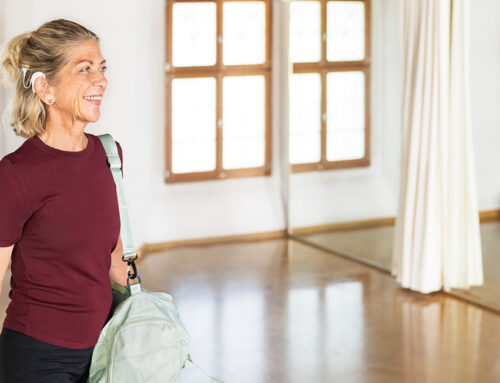Hearing in the fourth dimension
Since I started my work in MED-EL, I was occupied with the question: “How naturally do the users of our hearing implant systems hear?” Scientific evidence managed to cofirm that it was possible to understand speech flawlessly. But the question “HOW do they hear?” remained unanswered.
DI Ewald Thurner, the area manager of MED-EL Wien

Various audiometric measurements need to be performed prior to a hearing implant fitting. One subjective measurement method is electro-audiometry (EAM). For this, the external auditory canal is filled with physiological salt water, the test electrode is placed in the auditory canal and the ears are closed. Afterwards, very finely tuned electric pulses (or bursts) are applied, which can trigger auditory impressions. This method can also be used to diagnose the absence of the auditory nerve. This was once a routine, but today it is not done because the absence of the nerve is rare. For me as a young medical scientist, it was important to find out how it feels and sounds when I put this salty electrode into the ear of a two-year-old. So on my third or fourth day at work, I had pushed the electrode into my own ear and tested the measurement myself. I heard a nice pure tone in different frequencies. From that moment on, I was absolutely convinced of the EAM measurement.
Everything changed for my company in 1994 dramatically, as the MED-EL-C40 implant system was introduced. You could suddenly use very fast encoding strategies distributed over many channels and this way temporally map many sounds from the base to the tip of the cochlea. It was always possible to stimulate high-pitched tones at the base of the cochlea. This means that MED-EL was and still is (!) the first company in the world to also manage to stimulate the tip of the cochlea and generate low-pitched sound sensations up to about 100 Hertz, which first started with the C40. Moreover, MED-EL has optimized the electrodes in such a way that all physiologically applied frequency ranges in the cochlea can be reached – and this with residual hearing.
Before introducing C40 implant, the patients heard only high frequency tones. This caused distorted perception and percieved sounds resembled Mickey Mouse voice. I could simply not accept this. My main question to all C40 users always remained: “How do you hear?” Karl-Heinz Fuchs, the current CIA chairman, is postlingually deaf, which is why he is able to compare hearing before deafness and with a hearing implant. He was the first patient to make it clear as I got into his nerves, “Ewald, don’t worry, I hear normally. Both low and high voices, music and natural sounds. And now please stop bothering us with this question of “HOW”!”
If a surgery goes well and the modern MED-EL electrode covers the whole cochlear – from base to apex, then we don´t need to worry. That means that normal hearing will be guaranteed for our patient.
Since 1996, the first patients were implanted bilaterally. At the time, I was happy that I could do many tests myself, but I was also very grateful that our patients were willing to take part in diverse tests and studies. It was again Karl-Heinz Fuchs who told me on a very long car ride how well he could enjoy music after bilateral implantation. But, I didn´t want to believe him, so I persuaded him to test it out. I whistled a few songs for him and indeed, Karl-Heinz whistled the melodies flawlessly and convinced me once and for all.
So, the hearing situation can improve from absolute deafness to speech understanding with unilateral implantation. Depending on the patient, it can go up to one hundred percent. It requires much more attention for CI users to follow a conversation than it does for a person without hearing impairment. But, this highly focused, demanding listening is dramatically facilitated by bilateral fittings, according to our clients. Bilateral fitting reduces listening stress and it is no longer necessary to be fully concentrated.
Lastly, I again used my own experience, which I made with HiFi stereo systems. I have always been a music fan and my father had an old, huge tape recorder. You could make stereo recordings with two microphones with it. As a teenager, I occupied myself a lot with this device and tried many things out. A ‘mono’ button was a special feature of the device. You could switch the STEREO signal to MONO with only one hit. The resulting listening impression was so powerful for me that the phenomenon has captivated me forever. In the stereo mode, I could close my eyes and virtually see the orchestra in front of me. And then, I pressed the ‘mono’ button. Suddenly, the world around me literally shrank and the sound impression was reduced to an auditory line exactly in the center of my head. This realization was really impressive.
For hearing people, hearing in stereo is the most natural thing in the world. The moment someone would press a ‘mono’ button in our lives, we would be missing acoustic three-dimensionality dramatically. And I claim that if there were a ‘single-side’ button, we would be missing much more than with mono. With mono, all of listening is lined up, but almost half of the listening is missing when you listen with one side only. It is like connecting only one speaker on a stereo system and leaving the second exit unused.
For me, natural hearing means to perceive nature with its diverse sounds. The highest form of doing so is spatial hearing.
We at MED-EL believe that the ultimate goal of any hearing implant must be to provide users with the best hearing experience possible. Thus, our development is focused in three core areas. First, the electrodes have to be as long as possible in order to stimulate the cochlea along its entire length. If this is successful, then we speak of Complete Cochlear Coverage or CCC. Second, it is important to have especially soft and flexible electrodes. This enables the atraumatic insertion into the cochlea, so that as few structures as possible are affected. Moreover, it is possible to preserve residual hearing in many cases this way. This feature is called Structure Presetvation or in short, SP. Lastly, the coding strategy certainly plays an important role in the natural hearing impression. Our fine structure coding (also Finehearing, or FH) makes it possible to transmit the fine pitch differences of the audiosignal to the neuronal structures, especially in the lower tones. These three aspects – CCC, SP and FH are referred to with one term Triformance. Last but not least, natural hearing includes hearing with two ears as well. So, we add another component to Triformance for our users – bilateral hearing.
By doing so, we follow Einstein – and we enter the fourth dimension!






